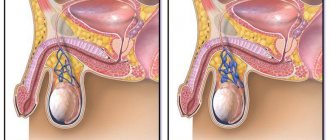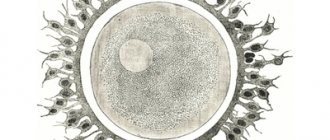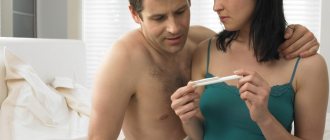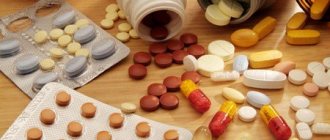Gynecologist at CLINIC21 Olga Arkadyevna Fedorova answered frequently asked questions from patients:
- How many eggs do women have?
- Is there a limited supply of eggs?
- Is it possible to recover eggs?
- What affects the number of eggs?
- How to determine the number of eggs?
How many eggs do women have?
Follicles with eggs are laid during the intrauterine development of a female fetus from 8 weeks to 12 weeks of pregnancy. During a normal pregnancy, about 9 million follicles are formed. If the mother is sick during these stages of pregnancy, takes some drugs on her own, works in hazardous industries, has bad habits, is exposed to any radiation (especially in the pelvic area), does not eat properly - all this will lead to the fact that fewer eggs are laid.
By the time a girl is born, about 2 million eggs remain in her ovaries; they are of poor quality, “broken,” undergo atresia and do not develop, undergo natural selection of genetic material, as well as a pathological course of pregnancy with the development of chronic placental insufficiency.
What affects the number of eggs?
With menarche, in each menstrual cycle, maturation and ovulation of 1, rarely 2 follicles occurs. In addition to the dominant follicle, its surroundings (“retinue”), up to 10-15 follicles, also die. The earlier menstruation begins, the shorter the menstrual cycle (the norm is 24-35 days), the more eggs are “wasted.” When the supply of eggs runs out in the ovaries, the woman goes into menopause (the norm is over 45 years), or early menopause (40-45 years), or premature depletion of the ovaries occurs and menopause occurs before the age of 40.
Follicle
It is a functional structural component of the ovary. Its main role is to support oocytes. One follicle contains a germ cell (oocyte) surrounded by somatic cells called granulosa cells, which in turn connect with theca cells.
The germ cell normally matures in a microscopic part of the inner wall of the follicle during the spontaneous or stimulated ovarian cycle.
Puberty begins with approximately 400 k in the ovary, each of which has the potential to release a cell in a woman at ovulation for fertilization. While several develop in each cycle, only one ovulates. One follicle usually contains one cell structure, but exceptions occur when ovulation occurs twice per cycle, usually after ovarian stimulation for infertility treatment.
After ovulation, the follicle turns into a corpus luteum. Follicles that do not release reproductive cells disintegrate.
What helps preserve eggs in a woman’s body?
Pregnancy and breastfeeding, when a woman does not ovulate and does not menstruate. Do hormonal contraceptives preserve eggs because they also block ovulation? Here the opinions of experts differ.
Natural selection occurs in our body all the time, and the healthiest and highest quality egg goes into ovulation. Accordingly, at 20-35 years old the probability of giving birth to a healthy child is much higher. After all, those eggs that did not undergo natural selection at age 20 ovulate later.
Good energy
Zita: “ Different parts of the egg require different nutrients. The outer layer (cell membrane) needs essential fatty acids Omega 3 and DHA. The “powerhouse” of the egg (mitochondrion) needs energy after fertilization, when the cell begins to divide. CoQ10 works with enzymes that help trigger the chemical changes in the body necessary for the reproductive system to function. B vitamins and zinc are also needed for cell division after fertilization.”
What causes faster ovarian depletion?
There are a lot of factors:
1. Bad habits.
Any. The earlier bad habits appear, the more damage they cause to the quantity and quality of eggs that are in the girl’s (woman’s) ovaries. When planning a pregnancy, when a woman gives up bad habits, further exposure to harmful factors on the eggs stops, but the eggs are not restored.
2. Sexually transmitted infections
(gonococci, chlamydia, myco-ureaplasma, etc.).
3. Surgical interventions on the ovary
regarding ovarian cysts, ovarian apoplexy, ovarian endometriosis, etc.
4. Chronic inflammatory diseases of the ovaries.
5. Excessive physical activity, sports nutrition.
6. Autoimmune diseases.
Sometimes a woman’s immune system begins to produce antibodies against the tissue of her own ovaries, often combined with autoimmune thyroiditis, diabetes, etc.
7. Chemotherapy, radiation or other cancer therapy.
If a woman of reproductive age is to undergo treatment for cancer, and she has not fulfilled her reproductive function (no children), it is possible to freeze eggs or ovarian tissue before starting therapy.
8. Stress.
Surprisingly.
Factors determining cell quality
Consistently and universally, what affects egg quality is related to age. Quality cannot be determined by examining the germ cells, measuring their susceptibility to fertilization by sperm.
Since they are with a woman from the moment of birth, they are exposed to various kinds of stress, this is inevitable. Diseases, anatomical and gynecological problems, stress, toxins, free radicals - these are the notable factors that affect the quality of eggs.
They can lead to small errors in DNA called chromosomal abnormalities.
Damaged DNA cannot be cured medically. If a cell is abnormal, then it can no longer be improved. The quality of the germ cell is genetically determined as euploid and aneuploid, and with age the percentage of aneuploid gametes increases more and more. The abnormal units usually do not fertilize or implant in the uterus, but in rare cases they can lead to miscarriage or genetic disorders such as Down syndrome.
How to determine the number of eggs?
How to determine how many eggs are left in a woman’s body?
To do this, you can take a blood test for:
- Anti-Mullerian hormone,
- Inhibin B,
- Follicle-stimulating hormone on the 2-4th day of the menstrual cycle in the morning on an empty stomach,
- Ultrasound OMT with counting the number of follicles up to 5-7 days of the menstrual cycle.
It’s not for nothing that, back in the old days, they said that during pregnancy the reproductive health of 2 generations ahead is laid: children and grandchildren. Take care of your reproductive health from a young age.
The health of our future children is mainly in our hands.
Make an appointment
Folliculogenesis
From birth, the ovaries contain a number of primordial/primordial follicles. During puberty, folliculogenesis begins - a continuous process, meaning that at any moment the ovary contains follicles at different stages of development, with certain structural characteristics.
Most die without ever developing. Some develop fully to produce a secondary oocyte, which is released by rupture.
The original/primordial formations undergo a number of critical changes, both histologically and hormonally. First they turn into primary/preantral, and then into secondary and tertiary. In the secondary stage they are known as antrum when they develop a fluid filled cavity called the antrum. At this stage of development, they become dependent on hormones, especially follicle-stimulating hormone, which leads to a significant increase in their growth rate. The tertiary or preovulatory follicle ruptures and releases an oocyte (which becomes a secondary oocyte), ending folliculogenesis.
- Maturation (follicular phase).
- Ovulation.
- Formation of the corpus luteum (luteal phase).
Inositol
Zita: “ Inositol plays an important role in fertility, as it participates in the development of follicles and regulates blood sugar levels. Inositol is part of the B vitamins and has been found in the follicular fluid of superior quality eggs. Animal studies have shown that myo-inositol helps the development of the blastocyst (an early stage of embryo development) and is especially beneficial for women with polycystic ovary syndrome. Inositol is also thought to increase ovarian insulin sensitivity, which helps improve egg quality. Women planning a pregnancy are advised to start taking inositol three months before the expected conception, during the period of egg development. "
Nutrition
Zita: “ Protein provides the building blocks for eggs and hormones. Protein from fish, chicken and meat, as well as plant sources, is critical for cellular health. A quarter of all cases of infertility are associated with ovulation disorders. Although recent research suggests that too much protein in the diet may also have a negative impact on fertility. However, dietary changes can improve and maintain ovarian function and therefore increase your chances of getting pregnant. Plant protein products are good, but try to reduce the amount of trans fats in your diet, as they have a negative effect on ovulation.
Micronutrients help egg development, and vitamin D plays a key role in this, especially for women undergoing IVF. Research shows that IVF is more successful in people with higher levels of the “sunshine vitamin.” Many of my clients are deficient in vitamin D, and this leads to hormonal imbalance. Omega 3 and essential fatty acids can affect egg maturation , so make sure you get enough of them in your diet. You also need iodine (for the thyroid, ovaries and breasts), zinc and beta-carotene.”
Life cycle features
To understand the biological process of egg maturation in the female body, it is very important to touch upon basic knowledge about their development. Initially, each woman has a certain number of female reproductive cells given to her by nature. A newborn girl's body already contains approximately 1-1.5 million follicles. Immediately after the birth of a girl, her follicles are not active. Maturation will begin much later - during puberty.
The appearance of the first menstruation is a signal from the female body that the maturation of the follicles has begun. On average, girls experience their first menstruation at 10-13 years of age. The time of their appearance is a very individual parameter. For some girls, they may first appear much later - by the age of 14-16.
From the moment menstruation appears until they completely stop with the onset of menopause, a woman is reproductive, that is, capable of having children. This period is called reproductive time. In a reproductive woman's body, eggs mature every month. This process occurs continuously. It was conceived by nature so that a woman could become a mother naturally and continue the family line.
The entire menstrual cycle of a woman can be divided into several successively changing phases:
- Menstruation. The first day of your period is the first day of a new menstrual cycle. The day before menstruation ends the previous menstrual cycle. The time interval between menstruation in each month determines the total duration of the menstrual cycle. According to statistics, it is on average 28-30 calendar days.
- Follicular . Characterized by the maturation of eggs. Lasts immediately until the follicle ruptures.
- Ovulation. It usually occurs in the middle of the menstrual cycle. On this day, the dominant follicle bursts, and the mature egg is released into the abdominal cavity.
- Luteal . It begins after the egg leaves the follicle. In place of the burst follicle, a special formation appears in the female body - the corpus luteum, which produces progesterone. If the egg remains unfertilized, the corpus luteum is subsequently reduced.
- Menstruation
- Ovulation
- High probability of conception
Ovulation occurs 14 days before the start of the menstrual cycle (with a 28-day cycle - on the 14th day). Deviation from the average value occurs frequently, so the calculation is approximate.
Also, together with the calendar method, you can measure basal temperature, examine cervical mucus, use special tests or mini-microscopes, take tests for FSH, LH, estrogens and progesterone.
You can definitely determine the day of ovulation using folliculometry (ultrasound).
- Losos, Jonathan B.; Raven, Peter H.; Johnson, George B.; Singer, Susan R. Biology. New York: McGraw-Hill. pp. 1207-1209.
- Campbell NA, Reece JB, Urry LA ea Biology. 9th ed. - Benjamin Cummings, 2011. - p. 1263
- Tkachenko B. I., Brin V. B., Zakharov Yu. M., Nedospasov V. O., Pyatin V. F. Human physiology. Compendium / Ed. B. I. Tkachenko. - M.: GEOTAR-Media, 2009. - 496 p.
- https://ru.wikipedia.org/wiki/Ovulation
Free Radical Protection
Zita: “ We all know that free radicals attack cells and speed up the aging process when it comes to beauty, but did you know that they pose the same danger to the reproductive system? Everything in the body, including eggs, sperm and reproductive organs, is made up of cells that must be protected from free radicals. Free radicals are a by-product of our metabolism, and although they are needed in small quantities, if you drink, smoke and eat poorly, they increase in number, damaging your eggs. The good news is that a diet rich in antioxidants neutralizes free radicals. Brightly colored fruits and vegetables give you plenty of protection, but also take supplements containing vitamin C, selenium and pine bark.










